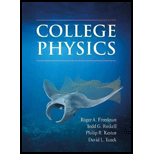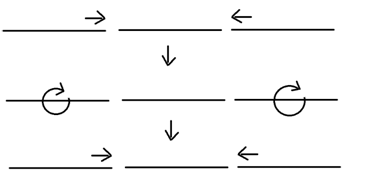
Concept explainers
How to use two magnetic rods to identify the unmagnetized rod.
Answer to Problem 1QAP
Keep one rod in the middle and approach other two rods from the both ends of the middle one. And then turn around the 2 rods which are approaching from the ends to change the end that reach the middle one. Do it repetitively changing the middle rod to one another until you find the rod that is in the middle which attracts the two approaching rods even if they are turned around.

Explanation of Solution
Magnetic rods attract unmagnetized iron rods. Magnetic rods attract each other if they are aligned in a way that two opposite poles of the rods meet each other. If the same poles of two magnetic rods are aligned, they repel each other.
When one rod is placed in the middle, if that is a magnet, it will attract the approaching unmagnetized rod regardless of the end of the unmagnetized rod. But the approaching magnetized rod from the other side will be attracted to the middle one in one orientation (only one pole), if it is turned around, it will be repelled.
If the middle one is unmagnetized rod, it will attract to the two magnets that are approaching from the two ends regardless of the orientation of the approaching rods.
Conclusion:
Unmagnetized rod can be determined by the property of magnets. Magnets repel each other when they are oriented in same poles and attract each other when they are oriented to meet the opposite poles. Unmagnetized iron rods attract to both poles of magnets.
Want to see more full solutions like this?
Chapter 19 Solutions
COLLEGE PHYSICS
- In simplest way, For each quadratic relation, find the zeros and the maximum or minimum. a) y = x 2 + 16 x + 39 b) y = 5 x2 - 50 x - 120arrow_forwardIn simplest terms and step by step Write each quadratic relation in standard form, then fi nd the zeros. y = - 4( x + 6)2 + 36arrow_forwardIn simplest terms and step by step For each quadratic relation, find the zeros and the maximum or minimum. 1) y = - 2 x2 - 28 x + 64 2) y = 6 x2 + 36 x - 42arrow_forward
- Write each relation in standard form a)y = 5(x + 10)2 + 7 b)y = 9(x - 8)2 - 4arrow_forwardIn simplest form and step by step Write the quadratic relation in standard form, then fi nd the zeros. y = 3(x - 1)2 - 147arrow_forwardStep by step instructions The path of a soccer ball can be modelled by the relation h = - 0.1 d 2 + 0.5 d + 0.6, where h is the ball’s height and d is the horizontal distance from the kicker. a) Find the zeros of the relation.arrow_forward
- Algebra & Trigonometry with Analytic GeometryAlgebraISBN:9781133382119Author:SwokowskiPublisher:Cengage
 Elementary Geometry For College Students, 7eGeometryISBN:9781337614085Author:Alexander, Daniel C.; Koeberlein, Geralyn M.Publisher:Cengage,
Elementary Geometry For College Students, 7eGeometryISBN:9781337614085Author:Alexander, Daniel C.; Koeberlein, Geralyn M.Publisher:Cengage, Holt Mcdougal Larson Pre-algebra: Student Edition...AlgebraISBN:9780547587776Author:HOLT MCDOUGALPublisher:HOLT MCDOUGAL
Holt Mcdougal Larson Pre-algebra: Student Edition...AlgebraISBN:9780547587776Author:HOLT MCDOUGALPublisher:HOLT MCDOUGAL  College Algebra (MindTap Course List)AlgebraISBN:9781305652231Author:R. David Gustafson, Jeff HughesPublisher:Cengage Learning
College Algebra (MindTap Course List)AlgebraISBN:9781305652231Author:R. David Gustafson, Jeff HughesPublisher:Cengage Learning Mathematics For Machine TechnologyAdvanced MathISBN:9781337798310Author:Peterson, John.Publisher:Cengage Learning,
Mathematics For Machine TechnologyAdvanced MathISBN:9781337798310Author:Peterson, John.Publisher:Cengage Learning, Glencoe Algebra 1, Student Edition, 9780079039897...AlgebraISBN:9780079039897Author:CarterPublisher:McGraw Hill
Glencoe Algebra 1, Student Edition, 9780079039897...AlgebraISBN:9780079039897Author:CarterPublisher:McGraw Hill





